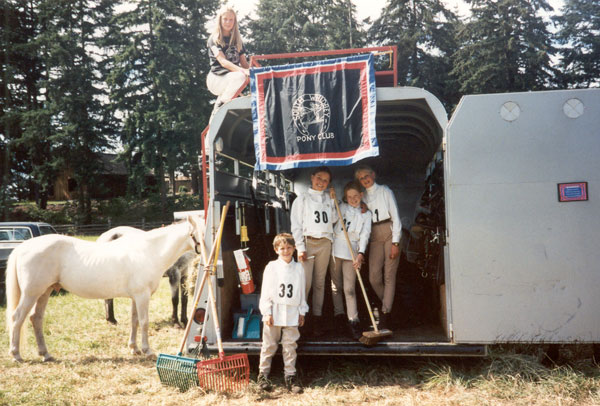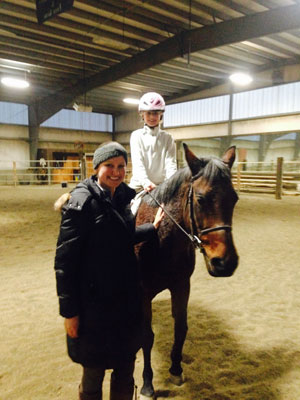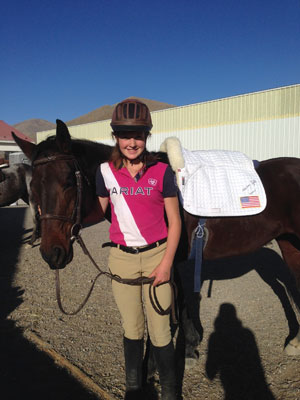I grew up in the U.S. Pony Club system, so I’m always looking for ways to give back.

I recently donated a lesson for a fundraiser of our local Pony Club chapter, but it also benefited me, because seeing the kids’ enthusiasm and determination in the lessons is always so refreshing and fun.
The girl who won the lesson this year was a D-2 rated Pony Clubber (walk, trot, canter basics) on her cute fuzzy Appy mare. When I showed up to teach her, her mom confessed to me that her daughter was a little bit nervous because she thought I might ask her to ride a piaffe, and she didn’t know how to do it.

She had been watching every YouTube video of me on Wizard, and was a little concerned that her pony might not be able to perform all the tricks Wizard did. How can you not smile when you hear something like that?
Teaching this lesson reminded me again of what a great system Pony Club is. Every time I show up to teach a Pony Club lesson, the kids are knowledgeable and eloquent, with a clear goal for their lesson. Pony Club is so fantastic in terms of teaching people to be critical and thinking riders.
From the youngest age, kids are taught to present a clear plan for their ride, with a goal and step-by-step outline on how they want to achieve it. They also learn how to analyze their ride afterward.
The protocol involves stating one thing you did well and one thing you would like to improve, then explaining how you would improve it. These are critical thinking skills I wish I could instill in so many adults in the horse world. Learning not to get emotional or frustrated, but rather, to think clearly about why something is happening in your ride is an invaluable skill.

I also love Pony Club for drilling the importance of a correct position. Pony Club horses usually are not fancy, and often not that well-trained, but that’s okay, because the focus is on the rider. The lower levels of Pony Club don’t even require that a horse “go on the bit.”
Rather, riders are judged on their ability to maintain a correct hand, leg and seat position, and be soft and sympathetic in the contact to the bit. When I was teaching this young Pony Clubber, I was very impressed at her perfect leg position, with heels stretching deep and her upper body staying tall and straight.
Her hands were absolutely quiet and correct in their position. And even when her pony was having its own opinions about wanting to run sideways and buck, instead of cantering, she was able to be effective in her corrections without ever losing her balance or correct position. I can’t help but think how beneficial it would be to so many dressage riders if they spent their first few years just focusing on their position and not even worrying about trying to get a horse on the bit.
Another critical aspect of Pony Club, which I believe is lacking in much of the horse show world, is that it teaches good horse management and veterinary knowledge above all else. Written and oral examinations are a major part of every rating, from the lowest level on up.
Every day, I still fall back on the veterinary knowledge and general horse management skills I learned in Pony Club.
It is mind-blowing to me how many riders there are who truly don’t have even this basic horse care knowledge. Being a good horse person involves much more than just sitting pretty in a saddle. Our horses are athletes, and we can’t expect them to perform for us if we don’t learn how to take care of every aspect of their well-being.

The last reason I am such a huge fan of the U.S. Pony Club is that it is all about the kids. Parents obviously have a big role in enabling their child to participate, but the crux of it is that the kids are responsible for themselves and their horses, which teaches them to be self-sufficient.
Pony Club has weekend-long horse shows (called “rallies”), where the parents are not allowed to have contact with the kids. They can watch their kids ride from a distance, but are in no way involved in the horse care or any of the behind-the-scenes action. Kids are responsible for setting up their own tack rooms and tacking up their own horses for a formal inspection, where they judged on their grooming and turnout.
The actual riding usually only accounts for about one-third of the total score. The rest comes from a written examination on veterinary and riding knowledge, and their formal inspections and “turn-backs” (where they check to see how well your horse is groomed and how well your tack is cleaned after you ride).
I loved Pony Club rallies when I was a kid. There was something so empowering about being all on your own, with just the help of your teammates, and working so hard to present a perfect horse and a perfect tack room. We would study for weeks before a rally, to be sure we did well on the written exams, and stay up all night scrubbing our tack so it shone.
From a young age, Pony Club kids learn the rewards of hard work and dedication, and are taught to be independent and smart horse people. I hope the U.S. Pony Club continues to thrive in the future, as I believe it is a wonderful resource for producing good riders and true horsemen. And I hope I can give back enough to the program that helped make me who I am today.











